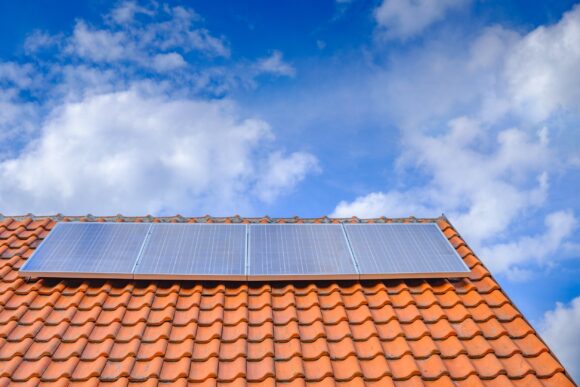This article is part of a sponsored series by IAT.
Solar installations have increased by 33% annually over the last decade. This can be attributed to federal policies such as the Solar Investment Tax Credit. The Solar Investment Credit Tax offers a tax incentive for solar units coupled with the increasing demand for clean energy.[1] In the commercial sector, environmental, social and governance initiatives have also been motivating factors for their growth.
Many building owners and operators fail to realize that solar panels aren’t “set it and forget it” equipment. They require routine maintenance and special care if a disaster strikes. If your business is in a hurricane-prone region, it’s critical to have a plan to de-energize your solar panels ahead of an oncoming storm to prevent loss and damage.
Safeguarding your solar installations during a storm
Hurricanes come with high winds and flooding, among other risks. Your solar panels can be damaged before, during and even after a hurricane.
Your maintenance staff should be trained by the manufacturer or third party in storing and de-energizing solar panels in the event of a hurricane. Create a written plan, including assigning responsibility for specific tasks.
Follow these steps to mitigate damage to your solar installation prior to a hurricane.
- Proper Storage. To mitigate damage to equipment and reduce wind drag, store and secure all tracking systems in a neutral position ahead of a storm. Adhere to the manufacturers’ recommendations to store and secure the modules.
- Power Down. To mitigate electrical losses caused by grid disruptions during the hurricane, de-energize the facility before the storm hits. Take it completely off the grid at the point of interconnect or in the switchyard. Then separate components by shutting off breakers at combiner boxes, trackers and inverters. This will help mitigate the effects of a single electrical loss, so it won’t negatively impact the entire facility.
- Secure Connections. Before the storm arrives, confirm that fasteners and clamps are secure. Check, repair and secure loose wiring as well. Pay special attention to any potentially compromised areas of the facility, including sections undergoing maintenance or repair.
- Ensure Components are Sealed. With hurricane winds regularly reaching over 100 mph, rain can easily enter even the smallest cracks and openings. All solar panel components must be regularly inspected for a waterproof seal, especially cabinets containing electrical equipment. Cabinets should be locked to prevent water damage.
- Remove Unsecured Objects. Unsecured objects can be propelled through the air during a hurricane and cause damage. Remove or secure any tools and equipment before the storm hits. Also pay special attention to items adjacent to the building such as pallets. If this is not possible, move the objects downwind to reduce damage.
- Inspect Drainage Ditches. Blocked drainage ditches retain water on site, leaving you open to additional water damage. Inspect the drainage system to ensure it’s free of debris and vegetative growth. Build flood barriers if you have time to help prevent undermining and erosion of racking system footings.
Recovering your equipment post storm
If the equipment was exposed to flood waters, they could be compromised and contaminated. As a result, flooded electrical equipment must be thoroughly inspected, cleaned, dried out and tested before use. If not, your installation runs a higher risk of serious damage or total loss.
Also, solar modules can produce power from sunlight even when they are disconnected, and modules sitting in water can pose an electrocution risk.
Always follow manufacturer requirements when recovering your equipment.
- Windings and dry type transformers should be dried at a temperature that does not surpass the insulation rating of the system before attempting usage. Again, check the manufacturer’s label for specific information about your equipment.
- Oil-filled transformers should be inspected. Draw oil samples from the tank’s top and bottom for analysis. Look for moisture droplets or a cloudy appearance. A lab should perform a test for dissolved water content. Depending on the results, a specialist may need to dehydrate the oil charge.
- Circuit boards can be very sensitive. If they were not energized while immersed in water and do not contain water-sensitive parts, they may be recovered. Clean in accordance with manufacturers guidelines.
- Other components may need to be rinsed with fresh, clean water after coming into contact with flood water. Planning and preparing can mitigate damage to your solar installation and expediate restoration in the event of a hurricane. Working with an expert can help identify weak points and other risks in your installation – and can ultimately save your investment from ruin.
Contact IAT for more information on preparing your solar installation for a hurricane.
By Katie Bloomquist
[1] Solar Energy Industries Association, “Solar Industry Research Data,” accessed July 7, 2022.
Was this article valuable?
Here are more articles you may enjoy.




 MAPFRE Accuses AAA of Violating Long-Time Exclusive Marketing Agreement
MAPFRE Accuses AAA of Violating Long-Time Exclusive Marketing Agreement  Florida Insurance Agency VP Sentenced to 3 Years in Massive ACA Fraud Scheme
Florida Insurance Agency VP Sentenced to 3 Years in Massive ACA Fraud Scheme  Private Equity Firms Expected to Unleash Middle-Market M&A Deals, Survey Says
Private Equity Firms Expected to Unleash Middle-Market M&A Deals, Survey Says  Billionaire NFL Owner Suing Over Billboards Near His LA Stadium
Billionaire NFL Owner Suing Over Billboards Near His LA Stadium 

